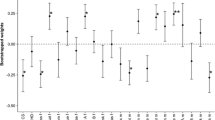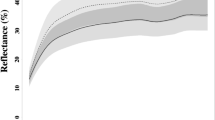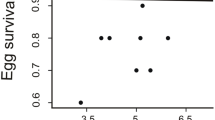Abstract
Carry-over effects refer to processes that occur in one season and influence fitness in the following. In birds, two costly activities, namely reproduction and moult, are restricted to a small time window, and sometimes overlap. Thus, colour in newly moulted feathers is likely to be affected by the costs of reproduction. Using models of bird vision we investigated male colour change in a free-living population of blue tits (Cyanistes caeruleus) in three sampling occasions: spring 1, winter and spring 2. We related crown, tail, breast and cheek feather colouration after the moult (winter) to the intensity of infections by blood parasites during reproduction (spring 1). In the following spring (spring 2), we explored mating patterns with respect to changes in feather colour (springs 1 vs. 2). Males that were less intensely infected by the malaria parasite Plasmodium while breeding showed purer white cheek feathers in winter, which may indicate higher feather quality. Increased brightness in the white cheek was associated with better body condition during reproduction. In the following season, males with brighter cheeks paired with females that had noticeably brighter cheek patches compared to the male’s previous mate. These results suggest that the conditions experienced during reproduction are likely to affect moult and thus feather colouration, at least in the white patch. High quality individuals may allocate resources efficiently during reproduction increasing future reproductive success through variation in mating patterns. Carry-over effects from reproduction might extend not only to the non-breeding phase, but also to the following breeding season.



Similar content being viewed by others
References
Asghar M, Hasselquist D, Zehtindjiev P, Westerdahl H, Bensch S (2015) Hidden costs of infection: chronic malaria accelerates telomere degradation and senescence in wild birds. Science 347:9–12
Badás EP, Martínez J, Rivero-de Aguilar J, Miranda F, Figuerola J, Merino S (2015) Ageing and reproduction: antioxidant supplementation alleviates telomere loss in wild birds. J Evol Biol 28(4):896–905. https://doi.org/10.1111/jeb.12615
Badás EP, Martínez J, Rivero-de Aguilar J, Stevens M, van der Velde M, Komdeur J, Merino S (2017) Eggshell pigmentation in the blue tit: male quality matters. Behav Ecol Sociobiol 71(3):57. https://doi.org/10.1007/s00265-017-2286-4
Bates D, Mächler M, Bolker B, Walker S (2014) Fitting linear mixed-effects models using lme4. J Stat Softw 67:1–48
Bize P, Criscuolo F, Metcalfe NB, Nasir L, Monaghan P (2009) Telomere dynamics rather than age predict life expectancy in the wild. Proc R Soc B Biol Sci 276(1662):1679–1683. https://doi.org/10.1098/rspb.2008.1817
Blount JD, Vitikainen EIK, Stott I, Cant MA (2016) Oxidative shielding and the cost of reproduction. Biol Rev 91(2):483–497. https://doi.org/10.1111/brv.12179
Bolker BM, Brooks ME, Clark CJ, Geange SW, Poulsen JR, Stevens M, White HH, Jada-Simone S (2009) Generalized linear mixed models: a practical guide for ecology and evolution. Trends Ecol Evol 24(3):127–135. https://doi.org/10.1016/j.tree.2008.10.008
Cantarero A, Laaksonen T, Järvistö PE, López-Arrabé J, Gil D, Moreno J (2017) Testosterone levels in relation to size and UV reflectance of achromatic plumage traits of female pied flycatchers. J Avian Biol 48(2):243–254. https://doi.org/10.1111/jav.01032
Cohen J (1998) Statistical Power Analysis for the Behavioral Sciences. Dep. Psychol. New York Univ. New York, New York. 2nd Edition, 590 pp.
Cuthill IC (2006) Color perception. In: Hill GE, McGraw KJ (eds) Bird coloration. I. Methods and mechanisms. Harvard University Press, Cambridge, MA, pp 3–40
Cyr NE, Wikelski M, Romero LM (2008) Increased energy expenditure but decreased stress responsiveness during molt. Physiol Biochem Zool 81(4):452–462. https://doi.org/10.1086/589547
Dawson A, Hinsley SA, Ferns PN, Bonser RHC, Eccleston L (2000) Rate of moult affects feather quality: a mechanism linking current reproductive effort to future survival. Proc R Soc London B Biol Sci 267(1457):2093–2098. https://doi.org/10.1098/rspb.2000.1254
del Cerro S, Merino S, Martínez-de la Puente J, Lobato E, Ruiz-de-Castañeda R, Rivero-de Aguilar J, Martínez J, Morales J, Tomás G, Moreno J (2010) Carotenoid-based plumage colouration is associated with blood parasite richness and stress protein levels in blue tits (Cyanistes caeruleus). Oecologia 162(4):825–835. https://doi.org/10.1007/s00442-009-1510-y
Delhey K, Peters A, Johnsen A, Kempenaers B (2006) Seasonal changes in blue tit crown color: do they signal individual quality? Behav Ecol 17(5):790–798. https://doi.org/10.1093/beheco/arl012
Delhey K, Burger C, Fiedler W, Peters A (2010) Seasonal changes in colour: a comparison of structural, melanin-and carotenoid-based plumage colours. PLoS One 5(7):e11582. https://doi.org/10.1371/journal.pone.0011582
Dhondt AA, Kempenaers B, Clobert J (1998) Sparrowhawk Accipiter nisus predation and blue tit Parus caeruleus adult annual survival rate. Ibis 140:580–584
Doucet SM, Montgomerie R (2003) Multiple sexual ornaments in satin bowerbirds: ultraviolet plumage and bowers signal different aspects of male quality. Behav Ecol 14(4):503–509. https://doi.org/10.1093/beheco/arg035
Doucet SM, Mennill DJ, Montgomerie R, Boag PT, Ratcliffe LM (2005) Achromatic plumage reflectance predicts reproductive success in male black-capped chickadees. Behav Ecol 16(1):218–222. https://doi.org/10.1093/beheco/arh154
Doutrelant C, Grégoire A, Midamegbe A, Lambrechts M, Perret P (2012) Female plumage coloration is sensitive to the cost of reproduction. An experiment in blue tits. J Anim Ecol 81(1):87–96. https://doi.org/10.1111/j.1365-2656.2011.01889.x
Dreiss AN, Roulin A (2010) Age-related change in melanin-based coloration: females that become more female-like and males more male-like with age perform better in barn owls (Tyto alba). Biol J Linn Soc 101(3):689–704. https://doi.org/10.1111/j.1095-8312.2010.01503.x
Dyck J (1976) Structural colours. Proc Int Ornithol Congr 16:426–437
Endler JA, Mielke PW (2005) Comparing entire color patterns as birds see them. Biol J Linn Soc 86(4):405–431. https://doi.org/10.1111/j.1095-8312.2005.00540.x
Evans SR, Hinks AE, Wilkin TA, Sheldon BC (2010) Age, sex and beauty: methodological dependence of age- and sex-dichromatism in the great tit Parus major. Biol J Linn Soc 101(4):777–796. https://doi.org/10.1111/j.1095-8312.2010.01548.x
Fargallo JA, Merino S (1999) Brood size manipulation modifies the intensity of the infection by Haematozoa in female blue tits Parus caeruleus. Ardea 87:261–268
Fitze PS, Richner H (2002) Differential effects of a parasite on ornamental structures based on melanins and carotenoids. Behav Ecol 13(3):401–407. https://doi.org/10.1093/beheco/13.3.401
Fitzpatrick S (1998) Colour schemes for birds: structural coloration and signals of quality in feathers. Ann Zool Fennici 35:67–77
Fox J (2002) Bootstrapping regression models. Ann Stat 9:1218–1228
Fox J, Weisberg S (2011) An {R} companion to applied regression, Second Edi edn. Sage, CA
Galván I (2010) Plumage coloration can be perceived as a multiple condition dependent signal by great tits Parus major. Ibis (Lond 1859) 152(2):359–367. https://doi.org/10.1111/j.1474-919X.2009.00999.x
Griffith SC (2000) A trade-off between reproduction and a condition-dependent sexually selected ornament in the house sparrow Passer domesticus. Proc R Soc B Biol Sci 267(1448):1115–1119. https://doi.org/10.1098/rspb.2000.1116
Griggio M, Serra L, Licheri D, Campomori C, Pilastro A (2009) Moult speed affects structural feather ornaments in the blue tit. J Evol Biol 22(4):782–792. https://doi.org/10.1111/j.1420-9101.2009.01700.x
Griggio M, Hoi H, Pilastro A (2010) Plumage maintenance affects ultraviolet colour and female preference in the budgerigar. Behav Process 84(3):739–744. https://doi.org/10.1016/j.beproc.2010.05.003
Griggio M, Valera F, Casas-Crivillé A, Hoi H, Barbosa A (2011) White tail markings are an indicator of quality and affect mate preference in rock sparrows. Behav Ecol Sociobiol 65(4):655–664. https://doi.org/10.1007/s00265-010-1067-0
Gunnarsson TG, Gill JA, Atkinson PW et al (2006) Population-scale drivers of individual arrival times in migratory birds. J Anim Ecol 75(5):1119–1127. https://doi.org/10.1111/j.1365-2656.2006.01131.x
Gustafsson L, Qvarnström A, Sheldon BC (1995) Trade-offs between life-history traits and a secondary sexual character in male collared flycatchers. Nature 375(6529):311–313. https://doi.org/10.1038/375311a0
Halekoh U, Højsgaard S (2014) A Kenward-Roger approximation and parametric bootstrap methods for tests in linear mixed models—the R package pbkrtest. J Stat Softw 59:1–32
Hanssen SA, Folstad I, Erikstad KE (2003) Reduced immunocompetence and cost of reproduction in common eiders. Oecologia 136(3):457–464. https://doi.org/10.1007/s00442-003-1282-8
Hanssen SA, Folstad I, Erikstad KE (2006) White plumage reflects individual quality in female eiders. Anim Behav 71(2):337–343. https://doi.org/10.1016/j.anbehav.2005.04.021
Harrison XA, Blount JD, Inger R, Norris DR, Bearhop S (2011) Carry-over effects as drivers of fitness differences in animals. J Anim Ecol 80(1):4–18. https://doi.org/10.1111/j.1365-2656.2010.01740.x
Harshman LG, Zera AJ (2007) The cost of reproduction: the devil in the details. Trends Ecol Evol 22(2):80–86. https://doi.org/10.1016/j.tree.2006.10.008
Hart NS, Partridge JC, Cuthill IC, Bennett ATD (2000) Visual pigments, oil droplets, ocular media and cone photoreceptor distribution in two species of passerine bird: the blue tit (Parus caeruleus L.) and the blackbird (Turdus merula L.) J Comp Physiol A Sensory, Neural, Behav Physiol 186:375–387
Hegyi G, Szigeti B, Török J, Eens M (2007) Melanin, carotenoid and structural plumage ornaments: information content and role in great tits Parus major. J Avian Biol 38(6):698–708. https://doi.org/10.1111/j.2007.0908-8857.04075.x
Hemborg C, Sanz J, Lundberg A (2001) Effects of latitude on the trade-off between reproduction and moult: a long-term study with pied flycatcher. Oecologia 129(2):206–212. https://doi.org/10.1007/s004420100710
Hill GE (2006a) Female mate choice for ornamental coloration. In: Hill GE, KJ MG (eds) Bird coloration. II. Function and evolution. Harvard University Press, Cambridge, MA, pp 137–200
Hill GE (2006b) Environmental regulation of ornamental coloration. In: Hill GE, KJ MG (eds) Bird coloration. I. Mechanisms and measurements. Harvard University Press, Cambridge, MA, pp 507–560
Hill GE, McGraw KJ (2006) Bird coloration, volume 1, Mechanisms and measurements. Harvard University Press, Cambridge
Hill GE, Doucet SM, Buchholz R (2005) The effect of coccidial infection on iridescent plumage coloration in wild turkeys. Anim Behav 69(2):387–394. https://doi.org/10.1016/j.anbehav.2004.03.013
Jenni L, Winkler R (1994) Moult and ageing of European passerines. Academic Press, London
Johnsen A, Delhey K, Andersson S, Kempenaers B (2003) Plumage colour in nestling blue tits: sexual dichromatism, condition dependence and genetic effects. Proc R Soc Biol Sci Ser B 270(1521):1263–1270. https://doi.org/10.1098/rspb.2003.2375
Johnson JB, Omland KS (2004) Model selection in ecology and evolution. Trends Ecol Evol 19(2):101–108. https://doi.org/10.1016/j.tree.2003.10.013
Kemp DJ, Herberstein ME, Fleishman LJ, Endler JA, Bennett ATD, Dyer AG, Hart NS, Marshall J, Whiting MJ (2015) An integrative framework for the appraisal of coloration in nature. Am Nat 185(6):705–724. https://doi.org/10.1086/681021
Knowles SCL, Palinauskas V, Sheldon BC (2010) Chronic malaria infections increase family inequalities and reduce parental fitness: experimental evidence from a wild bird population. J Evol Biol 23(3):557–569. https://doi.org/10.1111/j.1420-9101.2009.01920.x
Komdeur J, Oorebeek M, van Overveld T, Cuthill I (2005) Mutual ornamentation, age, and reproductive performance in the European starling. Behav Ecol 16(4):805–817. https://doi.org/10.1093/beheco/ari059
Lind O (2016) Colour vision and background adaptation in a passerine bird, the zebra finch (Taeniopygia guttata). Royal Society Open Science 3(9):160383. https://doi.org/10.1098/rsos.160383
Loiseau C, Zoorob R, Garnier S, Birard J, Federici P, Julliard R, Sorci G (2008) Antagonistic effects of a MHC class I allele on malaria-infected house sparrows. Ecol Lett 11(3):258–265. https://doi.org/10.1111/j.1461-0248.2007.01141.x
López-Arrabé J, Cantarero A, Pérez-Rodríguez L, Palma A, Moreno J (2014) Plumage ornaments and reproductive investment in relation to oxidative status in the Pied Flycatcher Ficedula hypoleuca iberiae. Can J Zool 92(12):1019–1027. https://doi.org/10.1139/cjz-2014-0199
Mahr K, Griggio M, Granatiero M, Hoi H (2012) Female attractiveness affects paternal investment: experimental evidence for male differential allocation in blue tits. Front Zool 9(1):14. https://doi.org/10.1186/1742-9994-9-14
Martínez-de la Puente J, Merino S, Tomás G et al (2010) The blood parasite Haemoproteus reduces survival in a wild bird: a medication experiment. Biol Lett 6(5):663–665. https://doi.org/10.1098/rsbl.2010.0046
McGraw KJ, Gregory AJ (2004) Carotenoid pigments in male American goldfinches: what is the optimal biochemical strategy for becoming colourful? Biol J Linn Soc 83(2):273–280. https://doi.org/10.1111/j.1095-8312.2004.00388.x
McGraw KJ, Mackillop EA, Dale J, Hauber ME (2002) Different colors reveal different information: how nutritional stress affects the expression of melanin- and structurally based ornamental plumage. J Exp Biol 205(Pt 23):3747–3755
Merino S, Barbosa A (1997) Haematocrit values in chinstrap penguins (Pygoscelis antarctica): variation with age and reproductive status. Polar Biol 17(1):14–16. https://doi.org/10.1007/s003000050099
Merino S, Potti J, Fargallo JA (1997) Blood parasites of passerine birds from central Spain. J Wildl Dis 33(3):638–641. https://doi.org/10.7589/0090-3558-33.3.638
Merino S, Moreno J, José Sanz J, Arriero E (2000) Are avian blood parasites pathogenic in the wild? A medication experiment in blue tits (Parus caeruleus). Proc R Soc London Ser B Biol Sci 267(1461):2507–2510. https://doi.org/10.1098/rspb.2000.1312
Metcalfe NB, Monaghan P (2001) Compensation for a bad start: grow now, pay later? Trends Ecol Evol 16(5):254–260. https://doi.org/10.1016/S0169-5347(01)02124-3
Møller AP, Pomiankowski A (1993) Why have birds got multiple sexual ornaments? Behav Ecol Sociobiol 32:167–176
Møller AP, Merino S, Soler JJ et al (2013) Assessing the effects of climate on host-parasite interactions: a comparative study of European birds and their parasites. PLoS One 8:1–11
Morales J, Moreno J, Merino S et al (2007) Early moult improves local survival and reduces reproductive output in female pied flycatchers. Ecoscience 14(1):31–39.
Moreno J, Sanz J, Merino S, Arriero E (2001) Daily energy expenditure and cell-mediated immunity in pied flycatchers while feeding nestlings: interaction with moult. Oecologia 129(4):492–497. https://doi.org/10.1007/s004420100767
Nacher M, Singhasivanon P, Yimsamran S, Manibunyong W, Thanyavanich N, Wuthisen P, Looareesuwan S (2002) Intestinal helminth infections are associated with increased incidence of Plasmodium falciparum malaria in Thailand. J Parasitol 88(1):55–58.
Nilsson J-A, Svensson E (1996) The cost of reproduction: a new link between current reproductive effort and future reproductive success. Proc R Soc London B: Biol Sci 263(1371):711–714. https://doi.org/10.1098/rspb.1996.0106
Orledge JM, Blount JD, Hoodless AN, Royle NJ (2012) Antioxidant supplementation during early development reduces parasite load but does not affect sexual ornament expression in adult ring-necked pheasants. Funct Ecol 26(3):688–700. https://doi.org/10.1111/j.1365-2435.2012.01977.x
Örnborg J, Andersson S, Griffith SC, Sheldon BC (2002) Seasonal changes in a ultraviolet structural colour signal in blue tits, Parus caeruleus. Biol J Linn Soc 76(2):237–245. https://doi.org/10.1046/j.1095-8312.2002.00061.x
Osorio D, Vorobyev M, Jones C (1999) Colour vision of domestic chicks. J Exp Biol 202(Pt 21):2951–2959
Partan S, Marler P (1999) Communication goes multimodal. Science 283(5406):1272–1273. https://doi.org/10.1126/science.283.5406.1272
Prum RO (2006) Anatomy, physics and evolution of structural colors. In: Hill GE, KJ MG (eds) Bird coloration. I. Mechanisms and measurements. Harvard University Press, Cambridge, MA, pp 295–353
Robb GN, McDonald RA, Chamberlain DE, Reynolds SJ, Harrison TJE, Bearhop S (2008) Winter feeding of birds increases productivity in the subsequent breeding season. Biol Lett 4(2):220–223. https://doi.org/10.1098/rsbl.2007.0622
Ruiz-De-Castañeda R, Burtt EH, González-Braojos S, Moreno J (2015) Bacterial degradability of white patches on primary feathers is associated with breeding date and parental effort in a migratory bird. Ibis 157(4):871–876. https://doi.org/10.1111/ibi.12281
Saks L, McGraw K, Horak P (2003) How feather colour reflects its carotenoid content. Funct Ecol 17(4):555–561. https://doi.org/10.1046/j.1365-2435.2003.00765.x
Santos ESA, Nakagawa S (2012) The costs of parental care: a meta-analysis of the trade-off between parental effort and survival in birds. J Evol Biol 25(9):1911–1917. https://doi.org/10.1111/j.1420-9101.2012.02569.x
Sanz JJ (1999) Seasonal variation in reproductive success and post-nuptial moult of blue tits in southern Europe: an experimental study. Oecologia 121(3):377–382. https://doi.org/10.1007/s004420050942
Sanz JJ, Moreno J, Merino S, Tomas G (2004) A trade-off between two resource-demanding functions: post-nuptial moult and immunity during reproduction in male pied flycatchers. J Anim Ecol 73(3):441–447. https://doi.org/10.1111/j.0021-8790.2004.00815.x
Senar JC (2002) Great tits (Parus major) reduce body mass in response to wing area reduction: a field experiment. Behav Ecol 13(6):725–727. https://doi.org/10.1093/beheco/13.6.725
Serra L, Griggio M, Licheri D, Pilastro A (2007) Moult speed constrains the expression of a carotenoid-based sexual ornament. J Evol Biol 20(5):2028–2034. https://doi.org/10.1111/j.1420-9101.2007.01360.x
Seutin G (1994) Plumage redness in redpoll finches does not reflect hemoparasitic infection. Oikos 70(2):280–286. https://doi.org/10.2307/3545639
Shawkey MD, Pillai SR, Hill GE, Siefferman LM, Roberts SR (2007) Bacteria as an agent for change in structural plumage color: correlational and experimental evidence. Am Nat 169:112–121
Siddiqi A, Cronin T, Loew E et al (2004) Interspecific and intraspecific views of color signals in the strawberry poison frog Dendrobates pumilio. J Exp Biol 207(14):2471–2485. https://doi.org/10.1242/jeb.01047
Siefferman L, Hill G (2005) Evidence for sexual selection on structural plumage coloration in female eastern bluebirds (Sialia sialis). Evolution 59(8):1819–1828. https://doi.org/10.1111/j.0014-3820.2005.tb01828.x
Smith HG, Nilsson J-Å (1987) Intraspecific variation in migratory pattern of a partial migrant, the blue tit (Parus caeruleus): an evaluation of different hypotheses. Auk 104(1):109–115. https://doi.org/10.2307/4087239
Sorensen M, Hipfner J, Kyser T, Norris D (2009) Carry-over effects in a Pacific seabird: stable isotope evidence that pre-breeding diet quality influences reproductive success. J Anim 78:460–467
Spottiswoode CN, Stevens M (2011) How to evade a coevolving brood parasite: egg discrimination versus egg variability as host defences. Proc R Soc London B Biol Sci 278(1724):3566–3573. https://doi.org/10.1098/rspb.2011.0401
Stearns SC (1992) The evolution of life histories. Oxford University Press, Oxford
Stevens M (2011) Avian vision and egg colouration: concepts and measurements. Avian Biol Res 4(4):168–184. https://doi.org/10.3184/175815511X13207790177958
Stevens M, Stoddard M, Higham J (2009) Studying primate color: towards visual system-dependent methods. Int J Primatol 30(6):893–917. https://doi.org/10.1007/s10764-009-9356-z
Stevens M, Lown AE, Wood LE (2014) Color change and camouflage in juvenile shore crabs Carcinus maenas. Front Ecol Evol 2:1–14
Stoddard MC, Prum RO (2008) Evolution of avian plumage color in a tetrahedral color space: a phylogenetic analysis of new world buntings. Am Nat 171(6):755–776. https://doi.org/10.1086/587526
Sugiura N (1978) Further analysts of the data by akaike’ s information criterion and the finite corrections. Commun Stat - Theory Methods 7(1):13–26. https://doi.org/10.1080/03610927808827599
Svensson L (1992) Identification Guide to European Passerines. Natural History Museum, Stockholm
Svensson E, Nilsson J-Å (1995) The trade-off between molt and parental care: a sexual conflict in the blue tit? Behav Ecol 8:92–98
Valkiūnas G (2005) Avian malaria parasites and other Haemosporidia. New York, USA
Vorobyev M, Osorio D, Bennett ATD, Marshall NJ, Cuthill IC (1998) Tetrachromacy, oil droplets and bird plumage colours. J Comp Physiol A Neuroethol Sensory, Neural, Behav Physiol 183(5):621–633. https://doi.org/10.1007/s003590050286
Zanollo V, Griggio M, Robertson J, Kleindorfer S (2012) The number and coloration of white flank spots predict the strength of a cutaneous immune response in female Diamond Firetails, Stagonopleura guttata. J Ornithol 153(4):1233–1244. https://doi.org/10.1007/s10336-012-0855-x
Acknowledgements
We thank ‘El Ventorrillo’ field station for the use of their facilities and several field assistants who helped during fieldwork. We are indebted to L. M. Carrascal for his comments on the statistical analyses.
Funding
This study was funded by projects CGL2012-40026-C02-01 and CGL2012-40026-C02-02 from the MEC (Ministerio de Economia y Competitividad).
Author information
Authors and Affiliations
Corresponding author
Ethics declarations
The Junta de Castilla y León authorised the ringing and handling of blue tits in the study area (protocol number EP/SG/193/2013). All researchers manipulating birds held a specific ringing permit. Work in the field area was done with permission from J. Donés (Director of ‘Montes de Valsain’).
Additional information
Communicated by: Alexandre Roulin
Electronic supplementary material
ESM 1
(DOCX 3494 kb)
Rights and permissions
About this article
Cite this article
Badás, E.P., Martínez, J., Rivero-de Aguilar, J. et al. Colour change in a structural ornament is related to individual quality, parasites and mating patterns in the blue tit. Sci Nat 105, 17 (2018). https://doi.org/10.1007/s00114-018-1539-z
Received:
Revised:
Accepted:
Published:
DOI: https://doi.org/10.1007/s00114-018-1539-z




